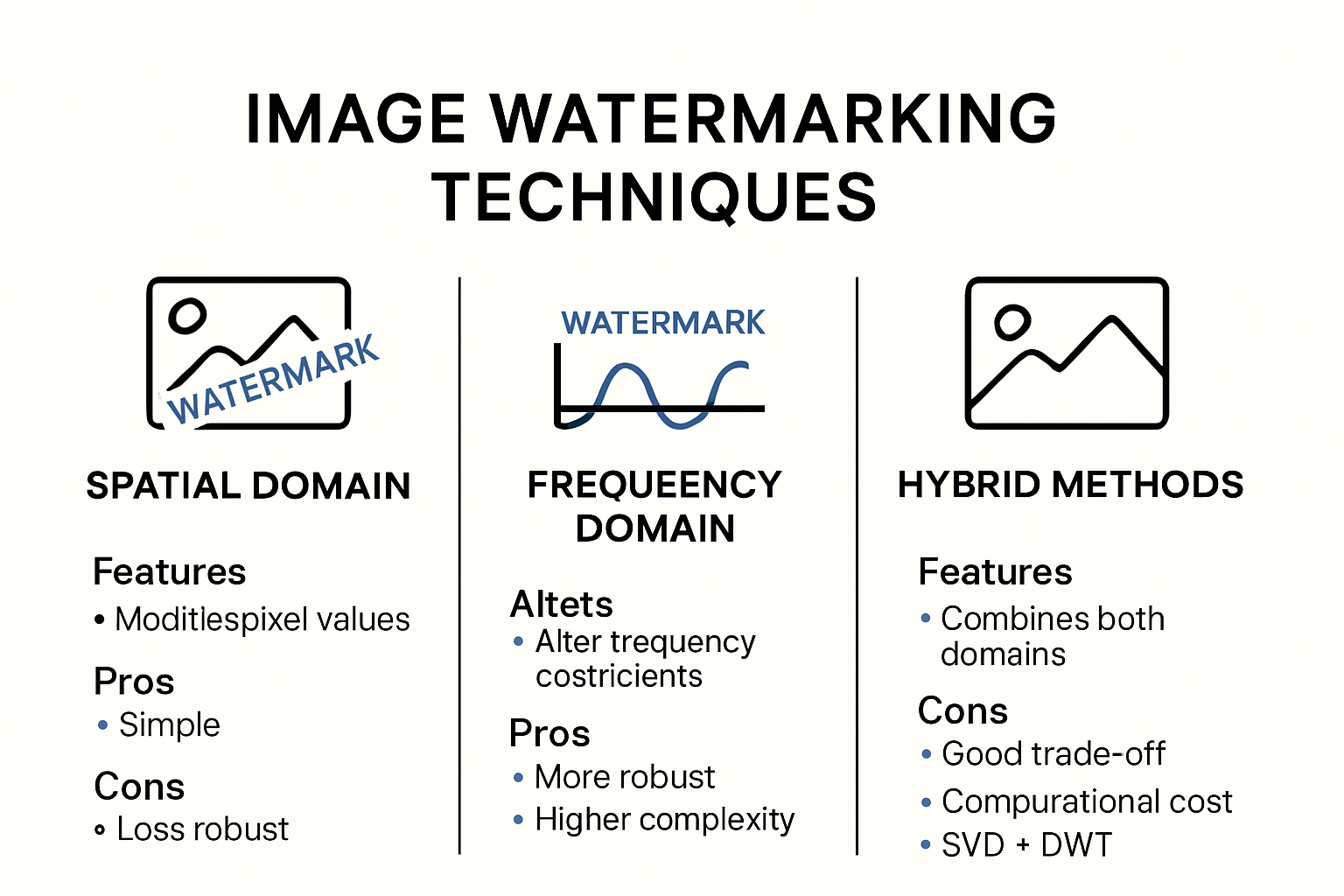Image theft is a growing problem for photographers and designers, with more than 2.5 billion digital images stolen online every day. That sounds massive, right? Here is the twist—most people assume slapping a quick watermark on a photo is enough. In reality, the latest watermarking techniques blend deep learning and adaptive algorithms, giving creators invisible layers of defense that are nearly impossible to crack. You might be surprised how much smarter your image protection can be in 2025.
Table of Contents
Quick Summary
| Takeaway | Explanation |
| Digital watermarking ensures ownership and protection | Techniques like spatial and frequency domain methods help track image usage and establish creator ownership while maintaining image quality. |
| Visible and invisible watermarking serve different purposes | Visible watermarks provide immediate copyright attribution while invisible watermarks offer undetectable tracking without visual disruption. |
| Advanced tools enhance watermarking strategies | Software like the ARIW-Framework and SEAL framework utilize adaptive and semantic-aware techniques to provide robust protection against digital threats. |
| Best practices optimize watermark effectiveness | Strategic design and placement of watermarks are essential to balance ownership visibility and the aesthetic integrity of the original work. |
Understanding Image Watermarking Techniques
Creative professionals face constant challenges protecting their digital visual assets in an increasingly complex online environment. Image watermarking techniques provide a critical defense mechanism for photographers, designers, and content creators seeking to safeguard their intellectual property while maintaining visual integrity.

The Fundamental Principles of Digital Watermarking
Digital watermarking represents a sophisticated method of embedding imperceptible yet traceable information directly into image files. At its core, this technique allows creators to establish ownership, prevent unauthorized usage, and track image distribution across multiple platforms. A comprehensive review by researchers revealed that modern watermarking strategies can be categorized into three primary approaches: spatial domain, frequency domain, and hybrid techniques.
Spatial domain techniques directly modify pixel values, offering simplicity but potentially compromising image quality. Frequency domain methods transform image data using mathematical algorithms like Discrete Wavelet Transform (DWT), providing superior imperceptibility and robustness. Hybrid approaches combine multiple techniques to maximize protection while minimizing visual disruption.
Here is a table summarizing and comparing the three main digital watermarking approaches discussed above.
| Approach | Method Used | Key Advantages | Limitations |
| Spatial Domain | Direct pixel modification | Simple implementation | Lower robustness, visible changes |
| Frequency Domain | DWT or similar transforms | Higher imperceptibility, robust | Increased computational demand |
| Hybrid Techniques | Combination of methods | Max protection, minimal visual impact | Complexity in design |
Advanced Watermarking Methodologies
Research from 2024 highlighted emerging watermarking techniques that leverage advanced computational methods. Deep learning networks have revolutionized image watermarking by introducing intelligent embedding and extraction processes. These sophisticated algorithms can:
-
Adapt dynamically to different image characteristics
-
Maintain high visual quality while embedding watermarks
-
Resist various digital attacks designed to remove or alter watermarks
The 2023 survey on deep learning watermarking methods categorized innovative approaches into three primary classifications: Embedder-Extractor models, Deep Networks as Feature Transformation, and Hybrid Methods. Each approach offers unique advantages for creative professionals seeking robust image protection strategies.
Practical Considerations for Creators
Effective image watermarking requires careful balance between protection and aesthetic preservation. Creators must consider factors such as watermark visibility, computational complexity, and potential image quality degradation. Professional-grade watermarking techniques should:
-
Remain virtually invisible to casual viewers
-
Provide clear ownership identification
-
Withstand potential digital manipulation attempts
-
Preserve original image resolution and color fidelity
Understanding these nuanced techniques empowers creative professionals to implement strategic digital asset protection. By selecting appropriate watermarking methods, photographers and designers can confidently share their work while maintaining strict control over intellectual property distribution.
The evolution of image watermarking continues to accelerate, driven by advances in machine learning, cryptographic techniques, and digital rights management. Staying informed about these technological developments allows creators to adapt their protection strategies proactively.
Types of Watermarks for Visual Professionals
Visual professionals require diverse watermarking strategies to protect their intellectual property across different platforms and use cases. Understanding the nuanced landscape of watermark types enables creators to select precise protection mechanisms tailored to their specific needs.
The following table compares visible, invisible, and robust watermarking techniques as described in this section.
| Watermark Type | How It’s Applied | Main Purpose | Key Advantages |
| Visible | Text/logo/graphic overlay | Immediate attribution, branding | Clear copyright notice, branding |
| Invisible | Embedded in metadata/image data | Tracking, authenticity verification | No visual impact, forensic tracking |
| Robust | Advanced algorithmic embedding | Survive digital transformations | Resilient to compression/attacks |
Visible Watermarking Strategies
Researchers from Purdue University define visible watermarks as direct overlay techniques that provide immediate visual copyright attribution. These watermarks serve dual purposes of protection and branding, allowing photographers and designers to establish immediate ownership recognition.
Visible watermarks typically manifest in several distinctive formats:
-
Text Overlays: Displaying photographer name or copyright symbol
-
Logo Placement: Strategically positioned brand identifiers
-
Transparent Graphic Elements: Subtle design markers that do not overwhelm original image composition
Professional visible watermarks require careful design considerations. They must balance protection requirements with aesthetic preservation, ensuring the underlying visual content remains engaging and professional.

Invisible Watermarking Technologies
Advanced digital forensics research reveals invisible watermarking as a sophisticated technique for imperceptible copyright protection. These digital markers are embedded within image metadata without altering visual perception, allowing creators to track image distribution and verify authenticity through specialized detection tools.
Invisible watermarking technologies offer several critical advantages:
-
Undetectable Protection: No visual disruption to original image
-
Forensic Tracking: Enables precise origin verification
-
Comprehensive Digital Rights Management: Supports complex intellectual property tracking
Robust Watermarking Techniques
Engineering research highlights robust watermarking as a sophisticated approach designed to withstand multiple digital transformations. These advanced techniques ensure watermark integrity across various scenarios including image compression, resizing, and potential manipulation attempts.
Robust watermarking techniques distinguish themselves through exceptional resilience:
-
Compression Resistance: Maintains embedded information during file size reduction
-
Geometric Transformation Tolerance: Survives image scaling and rotation
-
Attack Mitigation: Prevents deliberate watermark removal attempts
Creative professionals increasingly rely on these advanced watermarking strategies to protect digital assets in an environment of rapid technological evolution. By understanding and implementing sophisticated watermarking approaches, photographers, designers, and content creators can establish comprehensive intellectual property protection frameworks that adapt to emerging digital challenges.
The continuous advancement of watermarking technologies underscores the critical importance of staying informed about emerging protection methodologies. As digital content distribution becomes increasingly complex, robust and intelligent watermarking remains an essential tool for maintaining creative control and professional integrity.
Popular Tools and Software for Watermarking
Creative professionals require sophisticated digital tools to implement effective image watermarking strategies. The evolving landscape of watermarking technologies offers multiple software solutions designed to address diverse protection needs across different creative workflows.
Advanced Watermarking Frameworks
Researchers developing the ARIW-Framework have introduced an innovative adaptive robust iterative watermarking approach that significantly enhances visual quality and resilience against digital attacks. This framework optimizes encoder performance by generating resilient residuals and utilizing image gradients to dynamically adjust embedding strength at pixel levels.
Key characteristics of advanced watermarking frameworks include:
-
Adaptive Embedding: Intelligent strength adjustment based on image characteristics
-
Noise Resistance: Maintaining watermark integrity under various digital transformations
-
High Visual Preservation: Minimizing perceptible image degradation
Semantic Aware Watermarking Technologies
The SEAL framework represents a groundbreaking approach to semantic aware image watermarking. This innovative technology embeds semantic information directly into watermarks, enabling distortion-free verification without relying on extensive key pattern databases. By conditioning detection on original image content, SEAL demonstrates remarkable robustness against potential forgery attempts.
Semantic watermarking technologies offer significant advantages:
-
Content-Aware Embedding: Intelligent information integration
-
Forgery Detection: Enhanced protection against unauthorized modifications
-
Reduced Computational Complexity: Streamlined verification processes
Flexible Watermarking Solution Architectures
The MaskMark framework introduces a flexible approach to image watermarking that supports both global and local embedding techniques. This comprehensive solution achieves exceptional performance in watermark localization and multi-watermark embedding while maintaining superior visual quality and resilience against various digital attacks.
Flexible watermarking solutions provide creative professionals with:
-
Multi-Watermark Support: Ability to embed multiple ownership markers
-
Localization Capabilities: Precise watermark placement and extraction
-
Comprehensive Attack Resistance: Protection across diverse digital environments
Professional watermarking tools continue to evolve, integrating machine learning and advanced computational techniques to provide increasingly sophisticated protection mechanisms. Creative professionals must carefully evaluate software solutions based on specific workflow requirements, image types, and distribution platforms.
The rapid advancement of watermarking technologies underscores the importance of staying informed about emerging tools and methodologies. By selecting appropriate software frameworks, photographers, designers, and content creators can implement robust intellectual property protection strategies that adapt to the dynamic digital landscape.
Best Practices for Strong and Visible Watermarks
Creative professionals must develop strategic approaches to implement effective and resilient watermarking techniques that protect intellectual property without compromising visual aesthetics. Understanding and applying best practices ensures maximum protection and minimal visual disruption.
Strategic Watermark Design and Placement
Researchers exploring advanced watermarking techniques emphasize the critical importance of intelligent watermark design that balances visibility and aesthetic preservation. A well-crafted watermark should communicate ownership while maintaining the original image’s visual integrity.
Key design considerations include:
-
Optimal Transparency: Creating watermarks with carefully calibrated opacity levels
-
Strategic Positioning: Placing watermarks in areas that minimize visual interference
-
Consistent Branding: Utilizing uniform design elements across different images
Professional watermarking requires nuanced understanding of visual composition, ensuring that protective elements complement rather than detract from the original visual content.
Advanced Semantic Watermarking Strategies
The SEAL semantic watermarking framework introduces groundbreaking approaches to embedding robust, context-aware watermarks. This innovative technique integrates semantic information directly into watermark structures, providing enhanced protection against potential forgery and unauthorized modification.
Advanced semantic watermarking offers several significant advantages:
-
Context-Aware Embedding: Intelligent information integration based on image characteristics
-
Forgery Resistance: Enhanced protection mechanisms that adapt to potential manipulation attempts
-
Persistent Identification: Maintaining ownership markers through various digital transformations
Robust Watermarking Techniques
Deep learning research in dual watermarking reveals sophisticated approaches to creating imperceptible yet resilient copyright protection mechanisms. By leveraging advanced computational techniques, creators can develop watermarking strategies that offer exceptional protection while preserving image quality.
Comprehensive watermarking techniques should incorporate:
-
High Imperceptibility: Minimal visual disruption to original image
-
Strong Robustness: Resistance to digital manipulation and removal attempts
-
Computational Efficiency: Streamlined embedding and verification processes
Creative professionals must continuously adapt their watermarking strategies to address evolving digital challenges. This requires staying informed about technological advancements, understanding emerging protection methodologies, and implementing flexible approaches that can withstand sophisticated digital threats.
The landscape of digital asset protection demands a proactive and intelligent approach. By combining strategic design, advanced semantic techniques, and robust computational methods, photographers, designers, and content creators can establish comprehensive intellectual property protection frameworks that safeguard their creative work in an increasingly complex digital environment.
Frequently Asked Questions
What is digital watermarking?
Digital watermarking is a technique used to embed information directly into image files, allowing creators to establish ownership, track usage, and prevent unauthorized use.
What are the main types of watermarks?
There are three main types of watermarks: visible watermarks, which provide clear copyright attribution; invisible watermarks, which are undetectable and used for tracking; and robust watermarks, which maintain their integrity under various digital transformations.
How can I protect my images using watermarking?
You can protect your images by choosing effective watermarking techniques, such as adapting visible or invisible watermarks, utilizing advanced tools like the ARIW-Framework for adaptive embedding, and implementing best practices for watermark design and placement.
What tools can I use for watermarking?
Popular tools for watermarking include advanced frameworks like ARIW-Framework and SEAL, which provide adaptive embedding and semantic-aware technologies, allowing for effective and robust protection against digital theft.
Take Image Watermarking Protection Further with Pikd
After learning about advanced watermarking in the article, you might realize that traditional solutions do not always defend your creative work against theft or misuse. You want more than just a watermark—you need control over file sharing, visibility, and feedback, without risking image quality or your rights. The pressure to present your images professionally, while ensuring they are not copied or downloaded without your say, can be overwhelming for any creative.

Do not leave your visual content exposed. With Pikd, you can protect your high-resolution images by sharing only automatic low-res previews while keeping originals secure, and you choose exactly who can download or view your work. Organize your projects in branded galleries, collect client feedback in real time, and manage everything in one place—without losing the personal touch or ownership emphasized in the latest image watermarking techniques. Take control of your images today by signing up at Pikd and experience a new level of protection tailored for photographers and creative teams.

































